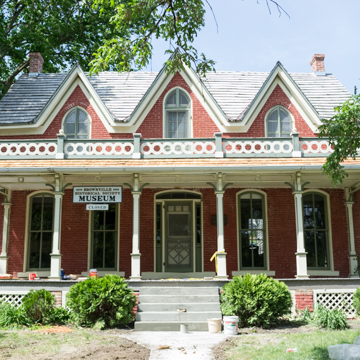In 1854, the same year the Nebraska Territory was created, Richard Brown founded the town that bears his name on picturesque terrain adjacent to the Missouri River. Here he established a ferry service that spurred the growth of the community as a major steamboat landing, overland freighting terminus, and river crossing for westward-bound settlers. Brownville was the first Nebraska community provided with a telegraph link to the eastern United States. The opening of a U.S. Land Office here in 1857 further enhanced the town’s status. Brownville’s population exceeded 2000 residents by the early 1870s making it one of Nebraska’s largest and most prosperous communities.
Built by Captain Benson M. Bailey, a Civil War Veteran, the Bailey House dates to that period in Brownville’s prosperity. It is located within the Brownville Historic District along Main Street, which contains a number of residential, commercial, and religious properties of historical importance. The one-and-a-half-story brick building is a good example of an I-house, which is typically two rooms wide and one room deep with a central passage and an extension at the rear. This I-house is Gothic Revival in style with steeply pitched roofs, a symmetrical front elevation featuring three prominent gables with pointed-arch windows extending into the gables, and a one-story, full-width porch.
During the last decades of the nineteenth century Brownville’s population declined due to financial depression, changing modes of transportation, and loss of the county seat—all of which drastically changed the nature of the town. Since the majority of Brownville’s extant buildings were erected prior to 1875 the small community now provides tourists an unrivaled glimpse of Nebraska’s early eastern settlement, due in large measure to the Brownville Historical Society, founded in 1956, to aggressively promote the preservation and public awareness of Brownville’s unique architectural heritage.
Currently, the Brownville Historical Society operates the Bailey House as a museum, displaying artifacts of the town’s legacy. Open to the public on weekends, it acts as an important historical anchor and tourist destination in this quaint southeastern town.
References
Magie, John O., “Brownville Historic District," Nemaha County, Nebraska. National Register of Historic Places Inventory-Nomination Form, 1970. National Park Service, U.S. Department of the Interior, Washington, DC.




















